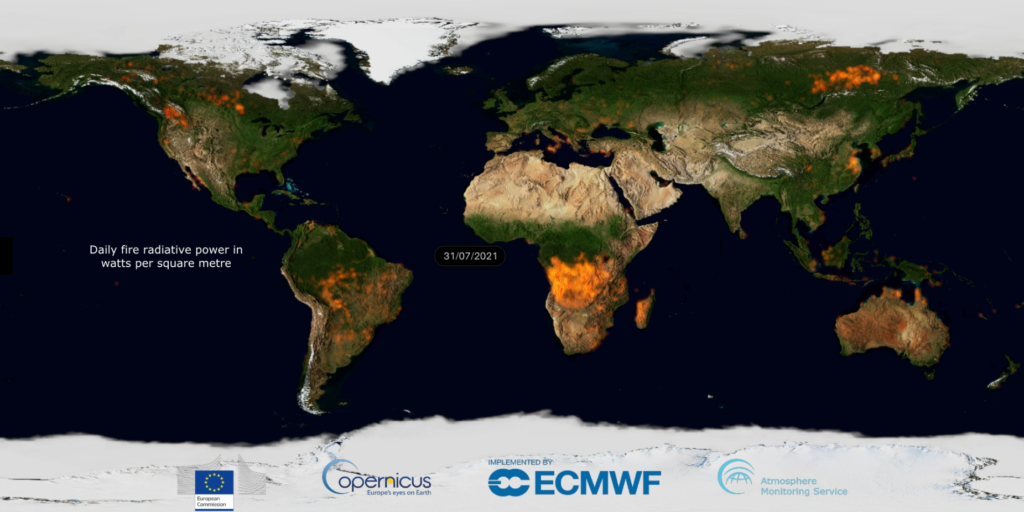A year of intense and prolonged wildfires has resulted in an estimated 1,760 megatons of carbon emissions being released into the atmosphere in 2021, according to scientists from the Copernicus Atmosphere Monitoring Service (CAMS).
The year also saw some of the highest estimated emissions in several regions around the world based on the CAMS 19-year Global Fire Assimilation System (GFAS) data set.
Implemented by the European Centre for Medium-Range Weather Forecasts (ECMWF) on behalf of the European Commission, with funding from the European Union, CAMS uses satellite observations to closely monitor active fires worldwide, providing estimated emissions and the impact on atmospheric composition and air quality.
In April 2021, intense and persistent fire activity was observed in western Siberia and Canada. The pattern of activity observed by CAMS scientists coincided with high surface temperature anomalies in these regions.
Several extreme wildfires occurred during summer 2021, which led to the highest estimated emissions for some of the months in the CAMS GFAS data set. This included vast expanses in North America, Siberia, eastern and central Mediterranean, and North Africa. July’s monthly total estimated emissions were soon the highest for 2021 in the CAMS GFAS data set with 343 megatons of carbon released into the atmosphere. More than half of the emissions were ascribed to fires in North America and Siberia, two of the worst affected regions. According to GFAS data, August followed suit with the monthly total estimated emissions being even higher, with an estimated 378 megatons of carbon released into the atmosphere globally.
Siberia
A huge number of wildfires raged across areas of western Siberia around Omsk and Tyumen, resulting in daily emissions at well above the mean of previous years in the data set for 2003-2021. Meanwhile, eastern territories were not as active early in the season. According to CAMS, the difference was clearly reflected in the surface temperature anomalies for the regions. In the summer, however, wildfires in the Sakha Republic in northeastern Siberia set the highest summertime total in the CAMS GFAS data set from June to August at more than double previous years. Furthermore, daily fire intensity, measured as Fire Radiative Power (FRP), reached significantly above-average levels from June right through to early September. Other regions in eastern Russia, including parts of the Arctic Circle, Chukotka Autonomous Okrug and Irkutsk Oblast, also experienced fires, but much less than in 2020 and 2019.
North America
Wildfires burned across western parts of North America for a significant period from the end of June to late August. The worst affected areas included several provinces in Canada, as well as California and the states in the Pacific Northwest of the USA. Among the fires was also the largest recorded fire in Californian state history, dubbed the Dixie Fire after the road in which it started. In all, the fires released estimated total carbon emissions of approximately 83 megatons into the atmosphere. The high intensity and persistence of the wildfire emissions could be seen in CAMS global forecasts as a large plume of smoke crossed the North Atlantic and, mixing with wildfires from Siberia, reached western parts of the British Isles and northwest Europe in late August before traveling across large parts of Europe.
The Mediterranean
Many countries around the eastern and central Mediterranean suffered several days of high-intensity wildfires in July and August, leading to high concentrations of fine particulate matter (known as PM2.5) and degraded air quality. The particularly dry and hot conditions throughout the summer months provided the ideal environment for intense and long-lasting wildfires. Turkey was the worst hit in July with CAMS GFAS data showing daily fire intensity at very high levels that were well above average for the region. Other countries also affected by the devastating wildfires included Greece, Italy, Albania, North Macedonia, Spain, Algeria and Tunisia.
North India
Seasonal crop stubble burning in Pakistan and northwestern India occurs every year between late September and the end of November. The haze and smoke pollution caused by this activity was clearly apparent in visible satellite imagery during October and November 2021 and has also been reflected in very high values of fine particulate matter and aerosol optical depth in the CAMS global forecasts throughout the region. Significant air pollution was observed, and reported, throughout the Indo-Gangetic Plain (IGP), affecting millions of people. The majority of the fires were in the Indian states of Punjab and Haryana.
Mark Parrington, senior scientist and wildfire expert at the ECMWF CAMS, said, “As the year draws to a close, we have seen extensive regions experience intense and prolonged wildfire activity, some of which has been at a level not observed in the last couple of decades. Drier and hotter regional conditions caused by global warming increase the risk of flammability and fire risk of vegetation and this has been reflected in the extremely large, fast-developing and persistent fires we have been monitoring.
“It is clear from 2021 that climate change is providing the ideal environments for wildfires, which can also be exacerbated by local weather conditions. Our five-day forecasts allow decision-makers, organizations and individuals to take mitigating action in advance of any pollution incidents,” he added.



